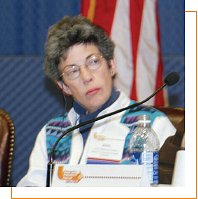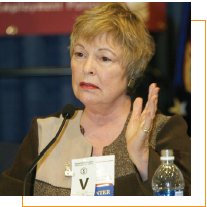PUTTING IT ALL TOGETHER: STRENGTHENING YOUR
AGENCY’S EMERGENCY PLAN
 |
|
Elizabeth Davis, Director of NOD’s Emergency
Preparedness Initiative (EPI), listened as other panelists addressed plan
implementation and maintenance. |
Throughout the Seminar of Exchange, participants were provided an
opportunity to explore a number of specific issues related to emergency
preparedness planning for people with disabilities, ranging from communicating
with employees to individualizing emergency preparedness plans. Each of these
topics is important in and of itself. However, an effective emergency
preparedness plan requires that these elements be thoroughly and appropriately
integrated to ensure the safety of all employees.
The objective of the final plenary session was to summarize the
discussions held throughout the Seminar, as well as to help participants manage
expectations and remain grounded in the reality of the planning process as they
move forward. To this end, a three-person panel outlined specific points that
participants should keep in mind. The panelists, national experts in the field
of emergency preparedness planning for people with disabilities, were Elizabeth
Davis, Director, Emergency Preparedness Initiative (EPI), National Organization
on Disability (NOD); June Isaacson Kailes, Associate Director, Center for
Issues and the Health Professions, Western University of Health Sciences; and
Edwina Julliet, Co-Founder, National Taskforce on Fire/Life Safety for People
with Disabilities.
Development
The first set of points concerned the development of emergency
preparedness plans and was delivered by Davis, who stressed the importance of
avoiding emergency preparedness planning in a vacuum. Davis stated that:
 |
|
June Issacson Kailes, Associate Director of the
Center for Disability Issues and Health Professions at Western University of
Health and Sciences. |
- Often those charged with developing an emergency
preparedness plan are doing so on the basis of a directive to create a plan,
but with little support, guidance, or commitment from within the agency.
As such, they are often unaware of other issues impacting plan development
and/or implementation. This can lead to duplication of efforts, general chaos,
and confusion.
- In order to develop the best plan for an agency, it is
imperative that federal agencies share information about all aspects of their
specific planning processes, including successes and failures. Davis
explained, “We want to make sure we replicate the successes and we
don’t replicate the failures. So, the sharing of information across agency
lines is "critical." Sharing also ensures that agencies are not relying on the
same resources or setting protocol that will conflict with other plans. This is
especially true in situations where agencies share office space or are housed
in close proximity.
- “Planning is a constant, ongoing effort.” As
such, plans and other associated documents should be regarded as living
documents or latest versions, but never as final or complete. Said Davis,
“The minute [the plan] says it’s the final version, is the minute it
gathers dust and cobwebs.”
- At all times, strive to exceed the minimum standards set
by the plan. For example, if a plan calls for having one drill a year on a
regular schedule, respond proactively. Raise the bar to one regularly
scheduled drill and one unannounced drill per year. In doing so, Davis said
that weaknesses in the plan will be revealed.
- “Successful plans and efforts come about when we
involve all levels of an organization, both in the planning as well as the
actual implementation "stage." According to Davis, you never know who will
find themselves in a position where they need to respond.
- Seek out creative solutions, which incorporate tools,
equipment, resources and new property in ways well beyond the original intended
use. Nevertheless, solutions do not have to be high-tech or expensive.
Often low-tech interim protocols can have as much of an impact as the final
tool and policy under development. The point is something can often be better
than nothing, as long as it is carefully considered and properly implemented.
Implementation
The second set of points targeted implementation of emergency
preparedness plans for people with disabilities. Kailes stressed that the
impetus for the successful implementation of an emergency preparedness plan is
to ensure that all the targeted individuals of an inclusive plan are taken into
consideration.
- Make it as comfortable as possible for people to
self-identify that they may require assistance during an emergency situation.
Kailes insisted, “Many people who need assistance will never, ever
identify as having a disability or having ... a special need." As such,
according to Kailes, the effectiveness of emergency preparedness plans can be
thwarted by an individual’s failure to self-identify that he or she has a
disability. She surmised that this can be primarily attributed to the fact that
“unfortunately, many people still attach a broad amount of stigma to
disability and do whatever they can to stay away from that effort.”
- Ensure the plan is understandable and readable. This
will impact plans positively. Specifically, emergency preparedness plans should
be formatted with bullets and pictures, as well as be available in Braille,
large print, cassette tape or electronic text versions.
- Establish support networks. Kailes specifically
referenced the “buddy system” as a perfect illustration of support
networks being beneficial. Recognizing that buddy systems are flawed in a
number of ways, Kailes implored the participants to “rethink” the
buddy system in broader terms. This means ensuring that everyone, including
individuals with disabilities, is trained in various aspects of the emergency
plan, despite any obvious limitations.
For example, while an
individual in a wheelchair may not be able to take someone down the stairs in
an evacuation chair, that individual could instruct someone else on doing so.
In developing implementation processes such as this, people who require
assistance during an emergency situation will “have a much broader network
they can rely on.”
- Practice emergency plans through a variety of drills.
Kailes’ fourth point re-emphasized the importance of practicing emergency
plans through planned and impromptu drills. Drills unveil weaknesses in
emergency planning, through a comprehensive analysis of employee feedback. To
this end, it is imperative that all people participate and provide feedback
regarding the successes and failures of a drill. While impromptu drills are an
excellent way to solidify employees’ grasp of the plan, it is also helpful
to “actually appoint key people that know when the next surprise drill
happens, so as to be able to evaluate everything that happens, and
…develop action steps accordingly.”
Maintenance and the Future
Juillet’s presentation focused on the maintenance of
emergency preparedness plans in light of looking toward the future. The
emphasis was on alarms, elevators, and evacuation devices. Her primary point
was that engineering trends, government codes, and industry standards will
shape emergency preparedness plans by requiring increased egress safety for the
building occupants with disabilities.
Alarms. With respect to alarms, Juillet explained that
design and performance requirements are governed by ‘NFPA-72’
(National Fire Protection Association). NFPA-72 permits voice annunciation
override of alarms. Nevertheless, there should be the incorporation of more
“intelligent” messaging, which would convey additional
information—other than evacuation and sheltering in place—and
consider the needs of persons with hearing impairments and cognitive
impairments.
Elevators. On the issue of elevators, Juillet acknowledged
the inconsistent messages regarding the use of elevators during an emergency.
Historically, elevator use during an emergency has been regarded as dangerous,
prohibited in virtually all instances. However, some elevators are indeed
operable during an emergency situation. Specifically, Juillet stated that such
elevators share several characteristics intended to ensure safety and
reliability: they must be installed in a smoke-proof hoistway constructed to a
two-hour fire resistance and pressurized against smoke infiltration, with
enclosed lobbies having a two-hour resistance (one-hour in buildings fully
equipped with sprinklers) and being pressurized.
 |
|
Edwina Julliet, Co-Founder of the National
Taskforce on Fire/Life Safety for People with Disabilities, explained the
current state of alarms, elevators, and evacuation devices. |
Evacuation Devices. The final issue discussed by Juillet
was evacuation devices. She defined evacuation devices as the “devices
people can transfer (in)to, to get up or downstairs to be able to evacuate the
building.” Juillet noted that currently there are no requirements for the
manufacture, use, or operation of this class of devices. The National Fire
Protection Association (NFPA) technical committee ‘Means of Egress’
(chapter 5 of the Life Safety Code 101) has convened a task group, Evacuation
Devices in Stairwells, to examine use, specifications for equipment and
operations, etc.
Juillet expressed the paramount need for an active committee or
council on these issues related to evacuation equipment, alarms, and,
particularly, elevator use for emergency egress in order to assure these
developments will be realized as quickly as possible. |



